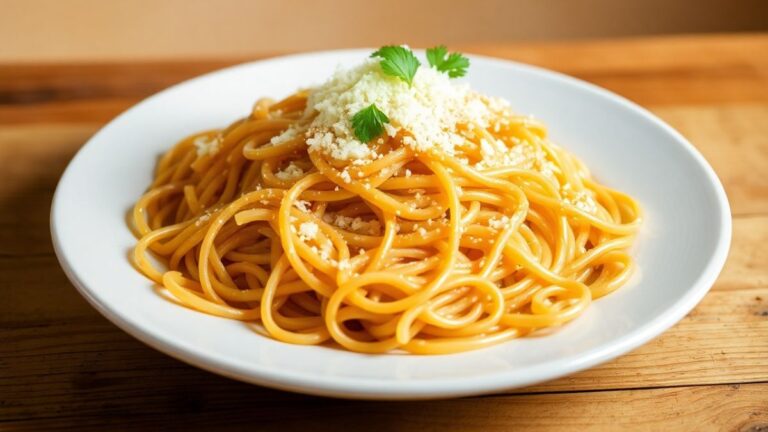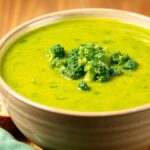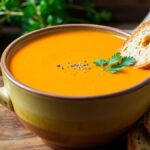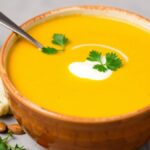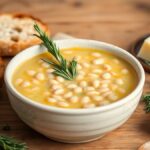Table of Contents
What are Garlic Parmesan Shirataki Noodles?
Garlic parmesan shirataki noodles are a low-carb, gluten-free alternative to traditional pasta, offering a unique twist on a beloved comfort food. Made from the konjac root, these noodles are typically translucent, chewy, and very low in calories, making them an excellent choice for those following ketogenic, paleo, or low-carb diets. Their neutral flavor acts as a perfect base for various seasonings, and when combined with garlic and parmesan, they provide a rich, savory taste that mimics the indulgent flavors of traditional garlic parmesan pasta dishes.
Shirataki noodles, often referred to as “miracle noodles,” have a high fiber content, which aids digestion and helps you feel full longer. When paired with the bold and savory notes of garlic and parmesan, the dish becomes a satisfying and flavorful option for those seeking a healthier pasta alternative. Importantly, garlic parmesan shirataki noodles offer versatility in the kitchen, easily adapting to different cuisines and flavor profiles.
How do you make Garlic Parmesan Shirataki Noodles?
Making garlic parmesan shirataki noodles is a simple process that requires minimal ingredients. The base of the dish, shirataki noodles, typically comes prepackaged in water, so the first step is to drain and rinse them thoroughly to remove any residual odor. This helps to ensure the noodles take on the flavors of the sauce you create.
Here’s a step-by-step guide to making garlic parmesan shirataki noodles:
- Prepare the Shirataki Noodles: Start by draining the noodles and rinsing them well under cold water to remove the natural odor.
- Sauté Garlic: In a pan, heat some olive oil over medium heat and add freshly minced garlic. Sauté for a minute or until fragrant.
- Add the Shirataki Noodles: Once the garlic is golden, add the rinsed noodles to the pan. Stir them to coat evenly in the garlic-infused oil.
- Season with Parmesan: Sprinkle a generous amount of grated parmesan cheese over the noodles, then stir continuously to ensure the cheese melts and combines with the garlic, creating a creamy texture.
- Finish with Herbs and Salt: Add salt, pepper, and fresh herbs like parsley or basil to enhance the flavor. Serve immediately.
The beauty of this dish lies in its flexibility; you can easily adjust the seasoning to your taste preferences, whether you prefer extra garlic or a stronger parmesan kick.
Are Garlic Parmesan Shirataki Noodles Healthy?
Yes, garlic parmesan shirataki noodles are a healthy choice for many people, especially those following low-carb or calorie-restricted diets. The main ingredient in shirataki noodles, konjac flour, is high in glucomannan, a type of soluble fiber that aids digestion and contributes to a feeling of fullness. This makes garlic parmesan shirataki noodles a great option for weight management.
Key health benefits of garlic parmesan shirataki noodles include:
- Low-Calorie: Shirataki noodles are incredibly low in calories, with a standard serving containing just 10 to 20 calories, making them an ideal choice for those seeking to reduce calorie intake.
- High in Fiber: The glucomannan fiber in shirataki noodles helps support digestive health and regulate blood sugar levels.
- Low-Carb: With very few net carbs, they are an excellent option for individuals following ketogenic or low-carb diets.
- Gluten-Free: Shirataki noodles are naturally gluten-free, providing a safe pasta alternative for those with gluten sensitivities or celiac disease.
- Promotes Satiety: The fiber in the noodles helps to keep you feeling full longer, reducing the likelihood of overeating.
While garlic parmesan shirataki noodles are healthy, it’s important to note that the added garlic and parmesan do contribute extra calories and fat. Therefore, you should balance this dish with other nutrient-dense foods, such as vegetables or lean proteins, to create a well-rounded meal.
What Goes Well with Garlic Parmesan Shirataki Noodles?
Garlic parmesan shirataki noodles can be paired with a variety of foods to create a satisfying, well-balanced meal. While the noodles themselves are flavorful, adding the right accompaniments can enhance the overall dining experience. Here are some ideas:
- Grilled Chicken or Shrimp: Both lean proteins pair wonderfully with the savory, cheesy flavor of garlic parmesan shirataki noodles. Chicken breast or shrimp can be seasoned with herbs and spices to complement the garlic.
- Roasted Vegetables: Roasted broccoli, zucchini, or bell peppers work well with the noodles, adding both texture and nutrients.
- Fresh Salad: A side salad with leafy greens, tomatoes, and a light vinaigrette can provide a refreshing contrast to the rich and creamy garlic parmesan noodles.
- Mushrooms: Sautéed mushrooms, such as cremini or shiitake, can be added for extra umami flavor and a meaty texture.
- Tomato Sauce or Pesto: For an added burst of flavor, consider drizzling a bit of tomato sauce or pesto over your garlic parmesan shirataki noodles.
By incorporating these accompaniments, you can create a balanced meal that satisfies various dietary needs and flavor preferences. Additionally, if you prefer a vegetarian option, you can simply load up on veggies for a nutritious, plant-based dish.
Can You Substitute Garlic Parmesan for Regular Noodles?
Yes, garlic parmesan shirataki noodles can easily substitute traditional pasta in many recipes. Due to their neutral flavor and adaptable texture, they work well as a replacement for regular noodles in dishes that typically rely on the creamy, savory notes of garlic and parmesan.
Here are some reasons why garlic parmesan shirataki noodles make an excellent substitute for regular noodles:
- Low-Carb Alternative: For those following a low-carb diet or managing blood sugar levels, shirataki noodles offer a suitable substitute for pasta, which is high in carbohydrates. Shirataki noodles have virtually no carbs, unlike regular pasta that can contain up to 40 grams of carbs per serving.
- Calorie-Friendly: Shirataki noodles have a significantly lower calorie count compared to regular pasta, which makes them a great option for weight management or those aiming to cut down on calories.
- Gluten-Free: Shirataki noodles are naturally gluten-free, making them a fantastic choice for people with gluten sensitivities, unlike many traditional pasta varieties that contain wheat flour.
- Versatility: The chewy, noodle-like texture of shirataki noodles easily absorbs sauces and flavors, making them ideal for a wide range of dishes such as garlic parmesan pasta, stir-fries, or cold noodle salads.
If you’re looking to make the swap, it’s important to note that while the texture of garlic parmesan shirataki noodles differs slightly from regular pasta, their ability to absorb rich, flavorful sauces means they can be just as satisfying when prepared correctly. As a result, this low-carb alternative can be a welcome addition to a variety of recipes, especially for those wanting to reduce their carbohydrate intake without compromising on taste.
Do You Rinse Shirataki Noodles Before Cooking?
Yes, it is highly recommended to rinse shirataki noodles thoroughly before cooking. The noodles are packed in water and may have a slight odor due to the natural properties of konjac, the root from which they are made. To remove this odor, simply drain the noodles from their packaging and rinse them under cold water for a few minutes. This step helps to eliminate the smell and ensures the noodles take on the flavors of your dish, like the garlic parmesan shirataki noodles recipe.
After rinsing, it’s also a good idea to dry the noodles by patting them with a paper towel or letting them sit in a colander for a minute or two. This helps the noodles absorb the seasonings and sauces better, resulting in a more flavorful dish. Whether you’re preparing a savory garlic parmesan shirataki noodle dish or a stir-fry, rinsing ensures that your meal tastes as intended without any lingering off-putting aromas.
Is it Okay to Eat Shirataki Noodles Every Day?
In moderation, it is generally safe to eat shirataki noodles every day, but there are a few things to consider. Shirataki noodles are made from konjac flour, which contains a type of soluble fiber called glucomannan. This fiber has numerous health benefits, including promoting digestion, regulating blood sugar levels, and contributing to feelings of fullness. However, consuming too much glucomannan fiber can cause digestive discomfort for some individuals, including bloating, gas, or even diarrhea, particularly if you’re not accustomed to high fiber intake.
If you plan to eat garlic parmesan shirataki noodles daily, it’s essential to ensure you’re also consuming a balanced diet that includes a variety of other nutrient-dense foods. Shirataki noodles are low in calories and provide few essential vitamins and minerals, so it’s best to pair them with vegetables, proteins, and healthy fats to meet your overall nutritional needs.
As with any food, it’s important to listen to your body and adjust your consumption if you experience any discomfort. If you have specific dietary concerns or health conditions, consult with a healthcare provider before making shirataki noodles a daily part of your diet.
Ingredients of Shirataki Noodles
Shirataki noodles are made primarily from konjac flour, which is derived from the root of the konjac plant, native to Asia. The main ingredient is glucomannan, a soluble fiber that gives the noodles their unique texture. This fiber is responsible for the noodles’ ability to absorb liquid, making them a great option for low-calorie and low-carb dishes.
Here’s a breakdown of the common ingredients in shirataki noodles:
- Konjac Flour (Glucomannan): This is the primary ingredient, which gives shirataki noodles their distinctive texture. It’s high in fiber but very low in calories and carbohydrates.
- Water: Shirataki noodles are often stored in water, which helps preserve their texture and freshness before cooking.
- Calcium Hydroxide: This is sometimes added as a stabilizer, helping to preserve the texture and prevent the noodles from breaking apart.
- Magnesium Chloride: Another common additive, which helps improve the noodles’ firmness and texture.
While garlic parmesan shirataki noodles are typically prepared with seasonings, cheese, and other ingredients, the base of these noodles is naturally low in fat, carbs, and calories. This makes them an ideal option for anyone looking to reduce their carbohydrate intake while still enjoying the satisfaction of a pasta-like meal.
Conclusion
Garlic parmesan shirataki noodles offer a healthy, low-calorie alternative to traditional pasta dishes while still delivering a rich and satisfying flavor. Whether you’re following a low-carb diet, managing your weight, or simply looking to try something new, these noodles can be a great addition to your meal rotation. Not only are they versatile in the kitchen, but they also pair well with a variety of proteins, vegetables, and sauces, making them suitable for different dietary needs and preferences.
By following simple preparation steps, you can easily transform garlic parmesan shirataki noodles into a delightful meal that combines both taste and nutrition. Their health benefits, including low-calorie content, high fiber, and gluten-free nature, make them an ideal choice for many people, especially those looking to reduce carbs or calories without sacrificing flavor. So, next time you’re in the mood for a delicious pasta dish, consider giving these noodles a try – they might just become your new favorite alternative.
FAQs about Garlic Parmesan Shirataki Noodles
1. Are Shirataki Noodles Safe to Eat?
Yes, shirataki noodles are safe to eat for most people. They are made from konjac flour, a natural, plant-based ingredient. However, if you’re not used to consuming a lot of fiber, it’s advisable to start slowly to avoid digestive discomfort.
2. Can You Cook Shirataki Noodles in the Same Way as Regular Pasta?
While shirataki noodles can be cooked similarly to pasta, they don’t need to boil for long. After rinsing, you can simply stir-fry or sauté them in your desired sauce. They absorb flavors well and don’t require much cooking time, typically just a few minutes.
3. Do Shirataki Noodles Taste Like Regular Pasta?
No, shirataki noodles don’t taste exactly like traditional pasta. They have a neutral flavor, allowing them to take on the taste of sauces or seasonings like garlic and parmesan. The texture is also different, as they are chewier and somewhat gelatinous compared to regular noodles.
4. Can I Use Shirataki Noodles in Soups or Broths?
Yes, you can use garlic parmesan shirataki noodles in soups or broths. Due to their ability to absorb liquids and flavors, they make a great addition to dishes like ramen or other brothy soups. Just be sure to rinse them first to remove the water they come in.
5. Can Shirataki Noodles Help with Weight Loss?
Yes, shirataki noodles can support weight loss efforts due to their low calorie and high fiber content. The fiber in shirataki noodles promotes a feeling of fullness, which may reduce overall calorie intake. However, it’s important to pair them with a balanced diet and regular exercise for optimal weight management.
6. Are Garlic Parmesan Shirataki Noodles Keto-Friendly?
Yes, garlic parmesan shirataki noodles are keto-friendly. Since they are low in carbs and calories, they fit well into ketogenic diets. The combination of the noodles with garlic and parmesan provides a flavorful, low-carb alternative to traditional pasta.
7. How Do I Store Shirataki Noodles?
Unopened shirataki noodles can be stored at room temperature, but once opened, they should be refrigerated in an airtight container. They should be consumed within a few days after opening for the best texture and flavor.
8. Can I Make Shirataki Noodles Ahead of Time?
While you can prepare garlic parmesan shirataki noodles in advance, it’s recommended to eat them soon after cooking, as the texture can change over time. If you want to store them, keep the noodles in the fridge and reheat them gently in a pan with a little oil or butter to restore their flavor and texture.
By understanding how to properly prepare, store, and incorporate garlic parmesan shirataki noodles into your meals, you can enjoy a tasty, healthy alternative to traditional pasta. These noodles are versatile and can be enjoyed in a variety of dishes, from stir-fries to soups, offering a satisfying meal option without the carbs.

